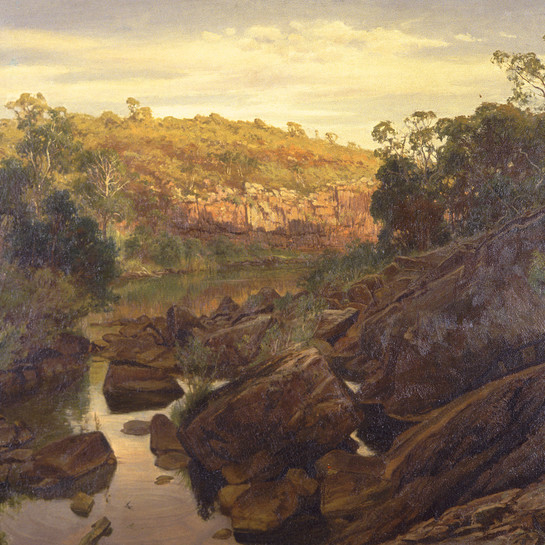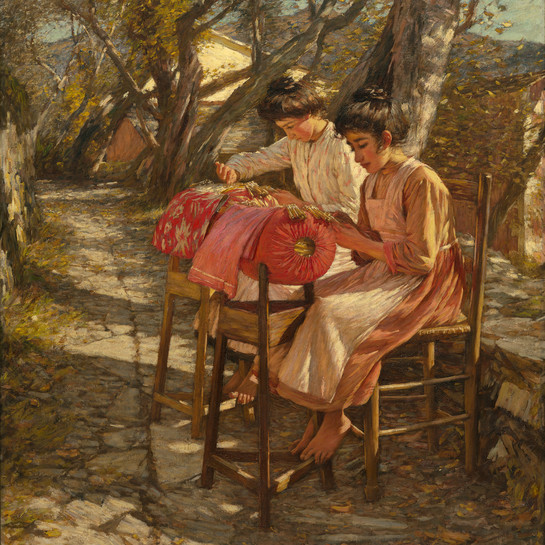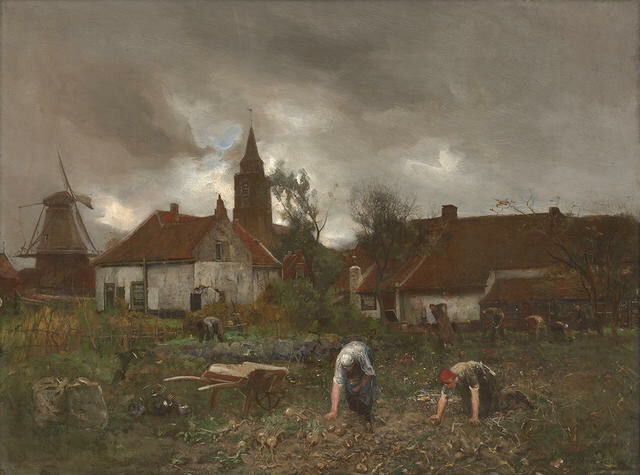Petrus van der Velden
Netherlands / Aotearoa New Zealand / Australia, b.1837, d.1913
Gathering Beet, Village of Rijnsburg
- c. 1888
- Oil on canvas
- Purchased with assistance from the Olive Stirrat Bequest, 1993
- 770 x 970 x 50mm
- 93/43
- View on google maps
Tags: carts, churches (buildings), clouds, farms, food, landscapes (representations), people (agents), religious buildings, trees, urban landscapes, vegetables, windmills, workers
The bending central figures in Petrus van der Velden’s Gathering Beet, Village of Rijnsburg owe a direct debt to Jean-François Millet’s Gleaners, which had challenged some visitors at the Paris Salon of 1857 with its elevation of common agricultural labourers. Van der Velden was one of several Dutch artists strongly influenced by Millet’s focus and direction. These beet pickers were working in Rijnsburg in the western Netherlands, near the rural village of Noordwyk-Binnen, where van der Velden was staying at the time – about two years before his departure for New Zealand. (Leaving for work, 2 October 2021 - 1 May 2022)
Exhibition History
The Weight of Sunlight, 16 September 2017 - 16 September 2018
Petrus van der Velden painted this atmospheric harvest scene about two years before his departure for New Zealand, while living at Noordwyk-Binnen, not far from Rijnsburg, the rural village depicted. Van der Velden achieved many notable successes in the Netherlands before arriving in New Zealand in 1890. But one achievement that he never would have fully appreciated was the strong impression he made upon the painter Vincent van Gogh at their meeting in 1882. Writing about van der Velden to his brother Theo in 1883, Vincent described him as ‘A man who evidently doesn’t seek civilization in outward things but is much further inwardly, much much much further than most people. In short, he’s a true artist, and I’d like to get to know him for I would trust him and I’m sure I would learn from him.’ Van der Velden became a powerful artistic presence in Christchurch, which he made his home base for eight years before spending six years in Sydney and his final nine in Wellington.
Quadrant: Four themes of Petrus van der Velden, 20 October 2006 – 25 March 2007
In the 1870s and 1880s, Van der Velden’s attention shifted from painting marine-scapes to depictions of rural life. Around 1888 he is thought to have painted at Rijnsburg, a small village to the west of Leiden and near Noordwyk Binnen, where he had settled in the same year. In this work, labourers in the foreground are carrying out very physical work collecting beet, while in the background others dig over the soil. Using the sombre tones favoured by the painters of the Hague School, the figures are dominated by a foreboding sky overhead and the church spire of Laurentiuskerk (Saint Laurence Church) dramatically piercing the clouds.
This work by Petrus Van der Velden is similar in theme to Millet's depictions of the labourers in the field. It belongs to the 19th century Dutch realist school that also focused on the lives of the peasants and country villagers. The small Dutch village of Rijnsburg is painted with the sombre tones favoured by the painters of the Hague School, to which Van der Velden was affiliated, and with the looser brushwork which was being explored by many artists at the end of the 19th century. The dramatic sky is a typical feature of the Dutch landscape tradition and, with the spire and windmill piercing the clouds, adds a slightly romantic element to this scene. (Label date unknown)
Petrus van der Velden was associated with the Dutch realist school, whose members were interested in portraying the simple lives of rural peasants and country villagers. The dramatic sky over the small village of Rijnsburg is a typical feature of the Dutch landscape tradition and, with the spire and windmill piercing the clouds, adds a slightly romantic element to the scene. The Dutch Hague School favoured dark somber tones and in Gathering Beet, Village of Rijnsburg Van der Velden has used the looser brushwork, which was being explored by many artists at the end of the 19th century. Born in Rotterdam, Van der Velden established himself as a painter, particularly of marine subjects. In 1890 he and his wife emigrated from Holland to New Zealand. However, Van der Velden struggled to make a living in Christchurch and went to Sydney in 1898. He returned to settle in Wellington in 1904 but died in Auckland. (Label date unknown)




